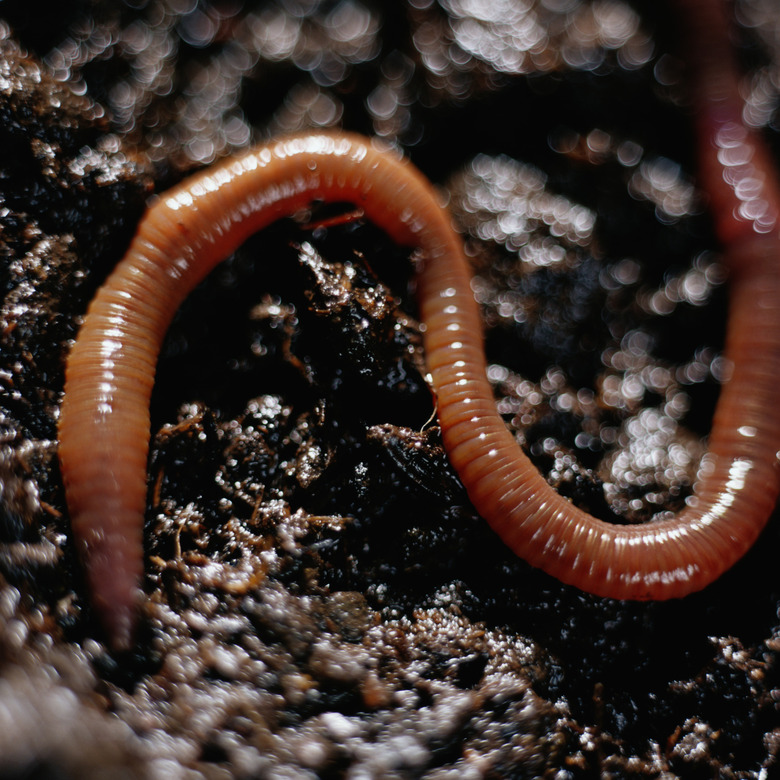The Importance Of Red Worms In The Ecosystem
Red worms (Eisenia fetida) work as scavengers in the ecosystem, feeding off of and decomposing dead plant and animal material. These earthworms are also called red wigglers and are used in man-made micro-ecosystems for composting and farming.
Red worms and other earthworms are an important food source in ecosystems for animals such as birds and even humans.
Scavengers
Scavengers
Red worms in a natural ecosystem feed in the leaf litter — the surface of the soil that contains dead plants, leaves and animal remains. As red worms gorge on decomposing matter, they leave behind castings — excrement or fecal matter — that is highly concentrated in nitrogen, phosphorus and potassium.
All of these are important nutrients that fertilize living plants. During the feeding and decomposing process, red worms help aerate the soil, creating pockets of air that allow for water and nutrients to flow more easily among plant roots.
Composting
Composting
Local gardeners and commercial farms have taken advantage of the mineral-rich castings that red wigglers leave behind. Red worm compost bins are used as way to naturally degrade food scraps and paper – a practice called vermicomposting ("vermi" is Latin for worms). Composting benefits the ecosystem by naturally recycling matter that might otherwise end up in a landfill.
The worm castings are collected from compost bins and used as fertilizer on gardens and houseplants. Red worm castings are used as an organic fertilizer; they are beneficial to the environment because they return natural minerals back to the ecosystem. Red worm castings provide additional benefits by serving as an alternative to nonorganic fertilizers, which can run off into nearby streams and harm native wildlife.
Many farmers also buy compost worms on top of naturally occurring worms for the purpose of fertilizing and composting their gardens/farms.
Prey
Prey
Another important role that red worms play in the ecosystem is being prey for other animals. Birds, such as hawks, favor earthworms as a food source. Red wigglers are also eaten by frogs, toads, fish and rodents.
Don't be surprised if you travel abroad and find earthworms as a delicacy in some cultures. Humans enjoy them too, and leaf-litter earthworms are an important high-energy food source for many native tribes. Red wigglers are also used by humans acquire food in the ecosystem; they are used as bait for fishing.
Environmental Impact
Environmental Impact
Scientists and naturalists have raised questions about the potentially negative effect that red worm farming may have on natural ecosystems where they are not a native species. In places where excess red worms from composting are be dumped into nearby ecosystems, non-native red worms potentially disrupt the ecosystem by competing with native worms species.
Red worms are prolific breeders and they only require leaf litter or surface material for food, making it easy for them spread quickly. The concern is that they can take over and alter the balance of an ecosystem where they are not a native species, and scientists are examining how red worms change the soil composition in a non-native ecosystem like forest areas.
Changes in soil composition due to invasive red worms may lead to the loss of some native plant species, ultimately changing the ecosystem.
References
- Pacific Horticulture: Earthworms
- Scientific American: How Fertilizers Harm Earth More Than Help Your Lawn
- 10,000 Birds: Red-shouldered Hawk Diet: From Worms to Chicken Thighs
- Minnesota Department of Natural Resources: American Toad
- Eat the Weeds: Earthworms
- Minnesota Department of Natural Resources: Earthworms
Cite This Article
MLA
Heeter, Kris. "The Importance Of Red Worms In The Ecosystem" sciencing.com, https://www.sciencing.com/importance-red-worms-ecosystem-22944/. 7 May 2019.
APA
Heeter, Kris. (2019, May 7). The Importance Of Red Worms In The Ecosystem. sciencing.com. Retrieved from https://www.sciencing.com/importance-red-worms-ecosystem-22944/
Chicago
Heeter, Kris. The Importance Of Red Worms In The Ecosystem last modified August 30, 2022. https://www.sciencing.com/importance-red-worms-ecosystem-22944/
